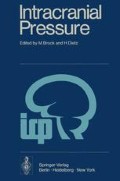Abstract
The changes in regional cerebral blood flow observed in diseased areas of the brain when arterial PCO2 and/or arterial blood pressure are altered have been attributed to variations in local tissue perfusion pressure (TPP) [1] and to pressure gradients within the brain [2, 3, 4]. Conclusions drawn from “cerebral” perfusion pressure (CPP) calculations appear to possess only a restricted value for the analysis of local circulatory phenomena since CPP is an overall value. Local brain tissue perfusion pressure, however, can only be determined if the blood pressure within the small intraparenchymatous brain vessels and the “interstitial” pressure of the brain tissue are known. While recent papers [5, 6] contain quantitative data on blood pressure in small vessels of the brain, no satisfactory method has hitherto permitted the measurement of brain tissue pressure. Implantable capsules [7] and balloons filled with saline [8] are inappropriate for this purpose since they involve excessive damage to the brain tissue.
Access this chapter
Tax calculation will be finalised at checkout
Purchases are for personal use only
Preview
Unable to display preview. Download preview PDF.
References
Brock, M., Hadjidimos, A. A., Deruaz, J. P., Fischer, F., Dietz, H., Kohlmeyer, K., Pöll, W., Schürmann, K.: The effects of hyperventilation on regional cerebral blood flow. On the role of changes in intracranial pressure and tissue-perfusion pressure for shifts in rCBF distribution. In: Toole, J. F., Moossy, J., Janeway, R. (Eds.): Cerebral Vascular Diseases, p. 114–123. New York: Grune & Stratton 1971.
Brock, M.: Cerebral blood flow and intracranial pressure changes associated with brain hypoxia. In: Brierley, J. B., Meldrum, B. S. (Eds.): Brain Hypoxia, p. 14–18. Philadelphia: J. B. Lippincott Co. 1971.
Brock, M., Markakis, E., Beck, J., Dietz, H.: Intracranial pressure gradients associated with cerebrovascular occlusion. Lancet, II, 824 (1971).
Brock, M., Beck, J., Markakis, E., Dietz, H.: Intracranial pressure gradients associated with experimental cerebral embolism. Stroke, 3, 123–130 (1972).
Kanzow, E., Dieckhoff, D.: On the location of the vascular resistance in the cerebral circulation. In: Brock, M., Fieschi, C., Ingvar, D., Lassen, N., Schürmann, K. (Eds.): Cerebral Blood Flow, p. 96–97. Berlin-Heidelberg-New York: Springer 1969.
Shapiro, H. M., Stromberg, D. D., Lee, D. R., Wiederhielm, C. A.: Dynamic pressures in the pial arterial microcirculation. Amer. J. Physiol. 221, 279–283 (1971).
Guyton, A. C.: A concept of negative interstitial pressure based on pressures in implanted perforated capsules. Circulat. Res. 12, 399–414 (1963).
Weinstein, J. D., Langfitt, T. W., Bruno, L., Zaren, H. A., Jackson, J. L. F.: Experimental study of patterns of brain distortion and ischemia produced by an intracranial mass. J. Neurosurg. 28, 513–521 (1968).
Scholander, P. F., Hargens, A. R., Miller, S. L.: Negative pressure in the interstitial fluid of animals. Science 161, 321–328 (1968).
Strømme, S. B., Maggert, J. E., Scholander, P. F.: Interstitial fluid pressure in terrestrial and semiterrestrial animals. J. appl. Physiol. 27, 123–126 (1969).
Snashal, P. D., Lucas, J., Guz, A., Floyer, M. A.: Measurement of interstitial ‘fluid’ pressure by means of a cotton wick in man and animals: an analysis of the origin of the pressure. Clin. Sci. 41, 35–53 (1971).
Ladegaard-Pedersen, H. J.: Measurement of the interstitial pressure in subcutaneous tissue in dogs. Circulat. Res. 26, 765–770 (1970).
Brock, M., Winkelmüller, W., Pöll, W., Markakis, E., Dietz, H.: Measurement of brain-tissue pressure. Lancet, II, 595–596 (1972).
Reinoso-Suarez, F.: Topographischer Hirnatlas der Katze. Darmstadt 1961.
Guyton, A. C.: Personal communication to M. B. in 1970.
Brock, M., Markakis, E., Pöll, W., Dietz, H.: In preparation.
Editor information
Editors and Affiliations
Rights and permissions
Copyright information
© 1972 Springer-Verlag Berlin
About this paper
Cite this paper
Pöll, W., Brock, M., Markakis, E., Winkelmüller, W., Dietz, H. (1972). Brain Tissue Pressure. In: Brock, M., Dietz, H. (eds) Intracranial Pressure. Springer, Berlin, Heidelberg. https://doi.org/10.1007/978-3-642-65486-2_32
Download citation
DOI: https://doi.org/10.1007/978-3-642-65486-2_32
Publisher Name: Springer, Berlin, Heidelberg
Print ISBN: 978-3-642-65488-6
Online ISBN: 978-3-642-65486-2
eBook Packages: Springer Book Archive

